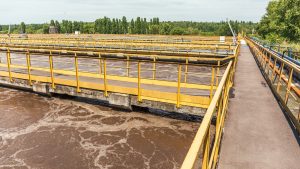In the water and wastewater industry, the responsibility to ensure pipes are in their optimal condition is shared by utility companies in addition to the property owners. The former faces the burden of providing a feasible system to monitor and maintain water main and communication pipe pipes. Property owners, however, are responsible for maintaining supply pipes that run underground from the street to the internal stop tap in your house, typically placed under the kitchen.
A water or wastewater network includes a maze of pipes, making it hard for asset managers to carry out routine checks properly. As they are typically laid under highways, it is not the most accessible, nor is it practical to inspect them manually. This also makes it hard to detect faulty pipes if water leaks occur. As a defective pipe can result in the wastage of water or wastewater or contaminate the treatment process, making it unsafe for the public, the need to infuse new-age pipe asset management techniques is essential. This article will explain some of the modern ways asset managers are tackling when dealing with pipes.
Lack of Pipe Asset Management Leads to Non-Revenue Water
Non-revenue water refers to water that has been supplied and lost from the network infrastructure. This can occur due to unbilled consumption, apparent losses and actual losses. Where pipes are damaged or not maintained properly, non-revenue water can occur due to actual losses as the water never makes it to the consumer. The types of leakage can be divided into three including reported bursts that are visible at the surface, unreported bursts that are unreported since they are not as visible and can only be detected through leak detection surveys and background leakage, which refers to small leaks that cannot be detected by subsequently worsen until it becomes detectable. The root cause for pipe leakages is multifold. It could be because the pipes are old or because the soil is corrosive to the pipe material and can not handle adverse weather conditions. It could also occur due to an increase in water or wastewater pressure or because the quality of the materials pipes was made of is no longer standardised enough.
Four Pillars of Leakage Control
As leakages are a recognised challenge in the water and wastewater industry, the International Water Association Water Loss Taskforce introduced four pillars of leakage control. The four pillars to minimise leakage include:
Pressure Management
Pressure management is integral to reducing non-revenue water and pipe bursts or leakages. According to the Water Services Association of Australia, a one per cent reduction in pressure leads to a 1.4 per cent reduction in leak flow rate. Additionally, a one per cent reduction in burst frequency reduces one per cent of pressure. An automotive pressure-reducing valve is generally implemented for this purpose. This lowers the level of pressure within the district-metered areas. New-age water and wastewater pipeline asset management infuses industrial Internet of Things (IIoT) sensors that can proactively monitor pressure levels in pipes, thereby taking countermeasures that prevent pipes from bursting.
Active Leakage Control
This refers to the use of preventive measures. Using artificial intelligence (AI), machine learning (ML) and data analytical capabilities, the pipe asset data is assessed to receive futuristic insights. Predictive and prescriptive analytics in this respect will forewarn asset managers of situations where pipes are prone to leakage, allowing maintenance crews to be deployed instantly to rectify it. As IIoT sensors automate receiving real-time information, an asset manager can easily direct the crew to the right location within the water or wastewater pipe network to prevent leakage. This significantly reduces the enormous costs that would have otherwise needed to be incurred to rectify damage to the pipe network.
Pipeline and Asset Management
Pipeline and asset management refer explicitly to the form of infrastructure. Where pipe network infrastructures need to be renewed, it costs exorbitant amounts. Asset managers must, therefore, effectively prioritise the lengthening of the life cycle of assets or construct more robust pipes which can withstand any condition. Technologies such as digital twin can help in this regard. It provides asset managers with the flexibility to test out using raw materials of different strengths to make pipes that have longer durability. Constantly monitoring the virtual replica of the pipe with simulations helps asset managers determine the best course of action when constructing and implementing a pipe network.
Speed and Quality of Repairs
The consequence of finding a leak has far more significant impacts. It is simply not a matter of water being wasted but also existing water being contaminated. It essentially disrupts the treatment process, thereby subjecting the water to contaminants. This leads to the public consuming water that is not safe for their health. Hence, the speed of addressing water leakages and the quality in which they are repaired plays a critical role to pipe asset management. The ability to address leakages proactively and in time can only be done with industry 4.0 technology. Since many pipe networks span an entire city or state, investing in a geographic information system (GIS) gives a blueprint for addressing pipe leakages.
Three New Techniques Used Today For Pipe Asset Management

It should be noted that the types of pipe involved in water and wastewater networks depend on the specific purpose. Detecting leakages in pipes or sewages has inspired asset managers to implement statistical methods, flow monitors, dye dilution, CCTV, infra-red thermography and others to maintain them. However, new techniques have also emerged over the years. They include:
Inline technologies – This refers to methods that use acoustic sensors in pressurised pipelines. Hence, whenever a leak occurs, the hissing sound or vibration that occurs gives the acoustic signal.
- SmartBall leak detection technology – This multi-sensor tool detects acoustic signatures related to gas or leaks in pressurised pipelines. This differs from traditional listening tools with limited use in large-diameter pipes.
Tethered Sahara inspection platform – This is a popular tool utilities use to detect leaks that run up to 1,800 meters. It can also be used to map pipeline alignment and is generally infused with CCTV devices to provide visualisation.
Address Leakages From Its Root Cause
At the heart of leakages include a weak asset management system that looks into the maintenance of your water and wastewater pipe networks. As the limited supply of freshwater bodies is already at risk of being reduced in the future, an asset manager must avoid making mistakes. Hence, non-revenue water, especially, cannot be unnecessarily wasted when it is a problem that can be fixed. The easiest and most reliable way to do so is integrating advanced technologies into your pipe asset maintenance operatiInvestingsting in a compact solution suite that handles the maintenance of your entire water or wastewater systems; you can ease the burden on your shoulder.







